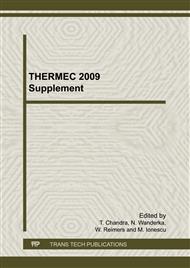p.633
p.639
p.645
p.651
p.657
p.663
p.669
p.675
p.681
Dynamic Growth of Ultra-Fine Austenite Grains Deformed above Ad3 Temperature in a Nb-V-Ti Steel
Abstract:
Generally, three typical behaviors are recognized in hot-deformation of austenite. However, considering that those austenite grains involved in single-pass deformation are mostly on the scale of dozens of micrometers or even much larger than that, it is meaningful to investigate hot-deformation behaviors of austenite grains smaller than 10μm. In the current paper, austenite grains of different sizes were prepared through repetitive treatment of rapid reheating and quenching with changing the holding temperature and/or holding time. Kinds of true stress-true strain curves at 900oC and 950oC indicate that austenitic deformation can be gradually coordinated by grain boundary behaviors, such as grain boundary sliding and/or diffusion. Simultaneously, the macroscopic deformation is more likely to be dominated through co-operation grain boundary sliding (CGBS).
Info:
Periodical:
Pages:
657-662
Citation:
Online since:
January 2010
Authors:
Price:
Сopyright:
© 2010 Trans Tech Publications Ltd. All Rights Reserved
Share:
Citation:


